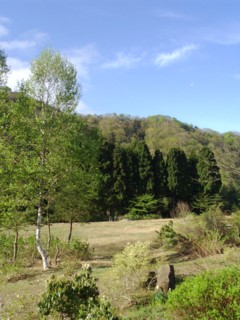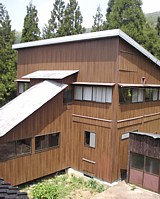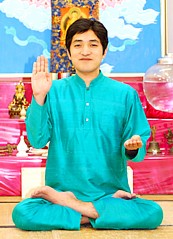|
|---|
 How to sit 5 Zazen as the perfection of patience (Adult Practice XXV) |
Wherever you sit, there will be plenty of opportunity to practice the perfection of patience. When I became the abbot of Antaiji three years ago, I did not make many changes. Still, one of the changes that I made right at once was that I moved zazen practice out of the new zendo: There were just too many disadvantages compared to the main hall. In the winter it was certainly easier to heat up than the main hall with its cracks in the wall, but because it is located on the second floor (on the first floor is the library) it will cool down below freezing temperature in the early morning, and even during the day time a lot of energy is lost when there is a wind blowing around the building. When the sun comes out, however, the second floor warms up quite quickly and sometimes people will open windows even during the winter - because it gets too hot! At present we are sitting in the dining room during the months of January, February and March. Because it has no walls that face the outside of the building directly, it doesn't cool down so much at night and is much easier to heat in the day time, with the temperature staying constant regardless of wind and weather. Also, the fact that up to one meter or more snow would cover the roof was not taken into consideration when the building was constructed, and the snow would only melt and slide a meter or so when the stove was burning during the day time, while it would freeze at night. When the snow that sled of the roof freezes without breaking off, it threatnes to destroy the windows in the second floor. The monks therefore had to get up on the roof from time to time to remove the snow by hand, which is not only time consuming but also dangerous. In summer, people could open all the windows above their heads and at the bottom of the wall. But this would only lead to a "cool breeze" when there is one blowing. More often than not, the new zendo would turn into a sauna: Not only does the sun shine directly into the windows, the heat from the roof tiles of the main hall and the living quarters would be reflected and hit the second floor of the new building. And even when the wind was blowing from time to time, the curtains that repalced the paper screens of the main hall would make a hell of a noise in the wind, and whenever the wind would blow away the curtain, the sun would be shining directly into the faces of the people sitting below the window. But worst of all was spring and autumn, when the temperature in the early morning of a sesshin could fall down to 5 degrees Celsius, but then, on a clear day, temperatures will rise to about 25 degress in the second floor in a couple of hours. As it is not possible to change clothes each time during kinhin, you started the day in the freezing cold, but around noon you were covered with sweat. And once it gets evening and you think that you've been through the worst: There you are, freezing again in your wet underwear! Because the new zendo was completely exposed to wind and sun, the difference between temperatures inside the building was even more extreme than if sitting outside. The practice we were aiming at at the time reminds me of a saying by Sen-no-Rikyu, the founder of tea ceremony: "Passing through the hells of cold and heat the tea dipper feels no suffering when it has no mind." (The master during a tea ceremony dips the ladle alternatingly into cold and boiling water when he is using it for pouring hot water into the pot, or cold water into bowls to rinse them.) The question is only: "How can we possibly have no mind?" There is a koan where a monk asks the master: "How shall we practice in the heat of summer or the cold of winter?" The master answers: "Simply practice in the spot where it is neither hot nor cold." "But where is such spot?" "When heat comes, die to the heat, when cold comes, die to the cold." I think the master is just telling us to sweat in the heat of summer and freeze in the cold of winter - and that is all. "No mind" means to make no addition to or subtraction from reality as it is. Therefore, the so called "perfection of patience" is more about acceptance than about grinding one's teeth in perseverance. But even though acceptance must be at the heart of our practice, the question posed itself: Why put up with conditions like that when we already have a hall for zazen which isn't perfect, but serves us much better? The main hall is cold in winter and hot in summer, but temperatures almost don't change at all during the day, which means that your body can accustome itself to the season. The light inside the hall is kind of dim, but that is just right for zazen (we are not reading books in there!). When you fall asleep on the cushion, it has other reasons (and people slept a lot in the new zendo as well). The new zendo was just too bright, and with the dazzling sun light shining directly through the windows, even those monks who hadn't slept in the main hall would close their eyes and be fast asleep before they knew it. At night, the fluorescent lights again gave too much light - an ordinary bulb is bright enough, and the warmth of the light helps to settle down on the cushion. Apart from its "cold" and nervously fluctuating light, the fluorescent lamps gave off a constant "buzz" sound which was hardly audible when the wind blows or birds sing, but late at night or in the early morning it was kind of disturbing. Three years ago I installed an ajustable light switch in the main hall, so that we can even dim down the light further - which in my experience can help people become more alert, rather than sleepy (but there are limits, of course, and the light should certainly be not too dim). So what can we learn from all of this? I think that our own attitude in zazen is most important, but we can see that the environment in which we sit also has a great influence on our practice. Although we will never be able to sit in an ideal environment (there will always be noises, and what one person thinks is "too hot" for another is "too cold", one might like it brighter while the other would prefer the light dimmer, and so on) we should check our options and choose the best one for zazen. When you are sitting with a group, you should of course accept the consensus of the group and not force your own preferences on the other members. Although I never thought that the new zendo was really suitable for practicing zazen, I did not said anything about it until I myself became the abbot. This has also to do with the fact that I did not live in Antaiji but in a different training monastery at the time of its construction, that means that although I and quite a number of other practioners did not like the new place, I did not feel in a position to say something like: "Well, you spend a whole year building this new zendo, but really, I think the old one is much better." I rather tried to use the years which we spent in the new zendo as an excercise in patience and acceptance. But let me continue next month with investigating "where to sit?", and after that we will procede to "physical preparations".
to be continued ... (Docho)
|
|---|
 
The former "New Zendo" |

Part 1: Childhood |
My name is Seikan. I was ordained as a novice monk at Antaiji last year. At that time, Docho-san asked me to write about what this means to me, and I tried to do so. Some time has passed since then, and I continue in my role as a novice monk, and continue exploring what it is about. On reflection, my experience has been like walking into an inconceivably large pair of overalls, where so far I have been moving around in just one pocket. Sometimes I feel at home inside the pocket, and at other times lost against the overalls' expanse, but at the same time grateful for their inclusiveness and space.
Trying to find a Buddha or enlightenment is like trying to grab space. Space has a name but no form. It's not something you can pick up or put down. And you certainly can't grab it... The Buddha is a product of the mind. (Bodhidharma, Bloodstream Sermon) In hindsight, being ordained was like a transplant of mind. As I write this, I remember having watched the film 21 Grams, involving a heart transplant, only a few days before setting off for Antaiji. I was in a bad way then. But transplants are wondrous ? not so much in prolonging our supposed continuity of self, as rather in surreptitiously undermining it. After all, what is it that survives a transplant? What dies? What belongs to us, and what is borrowed? What merely comes and goes? What is it that remains sitting and facing the wall while "dropping off body and mind"? I am not sure there is necessarily any direct continuity between what makes us want to follow the Buddha Way and that which walks it, between seeking to be ordained and living as a monk. While there is obviously a relationship between the "before" and "after", it does not seem straightforward. Thinking about it, I am reminded of Antaiji's rice cooker, which according to its inscription, relies on "fuzzy logic". After last year's ordination ceremony, we all enjoyed a lavish banquet meal, and I was surprised by how much I ate that night. I seriously suspect that fuzzy logic is somehow instrumental to becoming a monk. I have since returned to Melbourne, Australia, and will not be able to visit Antaiji again until sometime later this year. Melbourne itself is an ordinary "new world" city of a few million people, though reportedly it has been receiving international awards as "most liveable city". What exactly that means, or whom it includes and excludes, I am not sure. But as far as I know, there have been no local sightings of inoshishi. I have been based in this city for two decades, and now it is also the place where my daughter was born, and her mother before her, and the grandparents, and so on. For a developing child, such a sense of local continuity and belonging seems valuable. In much the same way, the tradition and lineage of our practice seem valuable to me as a novice monk, notwithstanding that it is in itself ultimately a deluded view. What mortals see are delusions. True vision is detached from seeing... To see nothing is to perceive the Way. (Bodhidharma, Wake-up Sermon) As a novice monk who is also a father, I have become curious of the relationship between seeing like a child and seeing like an adult. In a "fuzzy world" kind of way, both seem distinct but interconnected, not one and not two, with childhood deluded by its vision of one and adulthood by that of two. To our daughter Ella, who states her age as "nearly three", everything still appears more or less as part of herself. In that way, she exists in a kind of samadhi of self, prior to the adult split into self versus other. At the same time, though, she also exists prior to self-responsibility. This makes her dependent on care and rules and boundaries, which as her father it has been part of my role to help provide for her. I have found our two perspectives to be complementary. While Ella is reliant on being parented, she in turn reveals how to live all of life as one koan. Despite having had the benefit of Docho-san's teachings on "adult practice", as a novice monk I am myself a child once more, and like my daughter presumably reliant on external rules and boundaries. So I ask myself what these really are. When Gautama Buddha gave transmission to Mahakashyapa, he said of the dharma: "Where, after all, is it?" Dharma transmission is of course considered to be outside of teachings, but what about practicing in the role of a novice monk? If adult practice is in part about having learned to "wipe one's own arse", is it adequate to this goal just to keep following my day-to-day business? Or rather my memories of practicing at Antaiji? Or the sixteen ordination precepts? Or my nose wherever it is pointing? Does living in "most liveable" Melbourne come to mean that the Buddha Way eventually becomes just another name for a new restaurant, alongside the "Big Buddha", "Little Buddha", "Lucky Buddha", "Million Buddha", "Chocolate Buddha", "Emerald Buddha", and "Buddha's Belly"? I ask these questions rhetorically. And yet, even if there may be no ultimate contradiction between Buddhist practice and Buddha-styled trade names, it exemplifies the kind of superficial complexity that can cause confusion for a child. So what of it? When confusion does arise, I accept it as being part of my childhood and practice, and not a hindrance to either. Practically it really means nothing other than that I keep sitting with it and letting it be or not be, along with all else of the body and mind. Child, adult, monk, aware, confused, sitting... while time and again trying to hold on to this and that when there is nothing to hold on to. The truth is there's nothing to find. But you need a teacher and to struggle to make yourself understand. (Bodhidharma, Bloodstream Sermon) As a novice monk living in Australia, the only teaching I can draw upon on a daily basis, and generally all that there is to my practice, comes back to doing zazen. Perhaps I am deluding myself about what it takes to be a monk, or perhaps by not sitting sesshin every other week I may not even be sitting enough, and yet somehow just sitting seems enough. So I sit zazen in the morning and night, and continue in my role as a novice monk.
to be continued ... (Seikan)
|
|---|
  (Part 3) | Sorry, couldn't do this translation this month. Will appear next month. (muho) |
|---|
